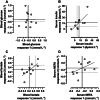Are there interindividual differences in the reactive hypoglycaemia response to breakfast? A replicate crossover trial
- PMID: 39231870
- PMCID: PMC11519142
- DOI: 10.1007/s00394-024-03467-y
Are there interindividual differences in the reactive hypoglycaemia response to breakfast? A replicate crossover trial
Abstract
Background: Following consumption of a meal, circulating glucose concentrations can rise and then fall briefly below the basal/fasting concentrations. This phenomenon is known as reactive hypoglycaemia but to date no researcher has explored potential inter-individual differences in response to meal consumption.
Objective: We conducted a secondary analysis of existing data to examine inter-individual variability of reactive hypoglycaemia in response to breakfast consumption.
Methods: Using a replicate crossover design, 12 healthy, physically active men (age: 18-30 y, body mass index: 22.1 to 28.0 kg⋅m- 2) completed two identical control (continued overnight fasting) and two breakfast (444 kcal; 60% carbohydrate, 17% protein, 23% fat) conditions in randomised sequences. Blood glucose and lactate concentrations, serum insulin and non-esterified fatty acid concentrations, whole-body energy expenditure, carbohydrate and fat oxidation rates, and appetite ratings were determined before and 2 h after the interventions. Inter-individual differences were explored using Pearson's product-moment correlations between the first and second replicates of the fasting-adjusted breakfast response. Within-participant covariate-adjusted linear mixed models and a random-effects meta-analytical approach were used to quantify participant-by-condition interactions.
Results: Breakfast consumption lowered 2-h blood glucose by 0.44 mmol/L (95%CI: 0.76 to 0.12 mmol/L) and serum NEFA concentrations, whilst increasing blood lactate and serum insulin concentrations (all p < 0.01). Large, positive correlations were observed between the first and second replicates of the fasting-adjusted insulin, lactate, hunger, and satisfaction responses to breakfast consumption (all r > 0.5, 90%CI ranged from 0.03 to 0.91). The participant-by-condition interaction response variability (SD) for serum insulin concentration was 11 pmol/L (95%CI: 5 to 16 pmol/L), which was consistent with the τ-statistic from the random-effects meta-analysis (11.7 pmol/L, 95%CI 7.0 to 22.2 pmol/L) whereas effects were unclear for other outcome variables (e.g., τ-statistic value for glucose: 0 mmol/L, 95%CI 0.0 to 0.5 mmol/L).
Conclusions: Despite observing reactive hypoglycaemia at the group level, we were unable to detect any meaningful inter-individual variability of the reactive hypoglycaemia response to breakfast. There was, however, evidence that 2-h insulin responses to breakfast display meaningful inter-individual variability, which may be explained by relative carbohydrate dose ingested and variation in insulin sensitivity of participants.
Keywords: Breakfast; Carbohydrate; Glucose; Metabolism; Response heterogeneity.
© 2024. The Author(s).
Figures






Similar articles
-
Effects of breakfast meal composition on second meal metabolic responses in adults with Type 2 diabetes mellitus.Eur J Clin Nutr. 2006 Sep;60(9):1122-9. doi: 10.1038/sj.ejcn.1602427. Epub 2006 May 3. Eur J Clin Nutr. 2006. PMID: 16670695 Clinical Trial.
-
Addition of Orange Pomace to Orange Juice Attenuates the Increases in Peak Glucose and Insulin Concentrations after Sequential Meal Ingestion in Men with Elevated Cardiometabolic Risk.J Nutr. 2016 Jun;146(6):1197-203. doi: 10.3945/jn.115.226001. Epub 2016 May 11. J Nutr. 2016. PMID: 27170728 Clinical Trial.
-
True Interindividual Variability Exists in Postprandial Appetite Responses in Healthy Men But Is Not Moderated by the FTO Genotype.J Nutr. 2019 Jul 1;149(7):1159-1169. doi: 10.1093/jn/nxz062. J Nutr. 2019. PMID: 31132105 Free PMC article.
-
Effect of meal sequence on postprandial lipid, glucose and insulin responses in young men.Eur J Clin Nutr. 2003 Dec;57(12):1536-44. doi: 10.1038/sj.ejcn.1601722. Eur J Clin Nutr. 2003. PMID: 14647218 Clinical Trial.
-
(Ultra-)long-acting insulin analogues versus NPH insulin (human isophane insulin) for adults with type 2 diabetes mellitus.Cochrane Database Syst Rev. 2020 Nov 9;11(11):CD005613. doi: 10.1002/14651858.CD005613.pub4. Cochrane Database Syst Rev. 2020. PMID: 33166419 Free PMC article.
Cited by
-
Continuous glucose monitor overestimates glycemia, with the magnitude of bias varying by postprandial test and individual - a randomized crossover trial.Am J Clin Nutr. 2025 May;121(5):1025-1034. doi: 10.1016/j.ajcnut.2025.02.024. Epub 2025 Feb 26. Am J Clin Nutr. 2025. PMID: 40021059 Free PMC article. Clinical Trial.
References
-
- Edinburgh RM, Hengist A, Smith HA, Travers RL, Koumanov F, Betts JA, Thompson D, Walhin JP, Wallis GA, Hamilton DL et al (2018) Preexercise breakfast ingestion versus extended overnight fasting increases postprandial glucose flux after exercise in healthy men. Am J Physiol - Endocrinol Metabolism 315(5):E1062–E74. 10.1152/ajpendo.00163.2018 - PMC - PubMed
Publication types
MeSH terms
Substances
LinkOut - more resources
Full Text Sources
Medical

